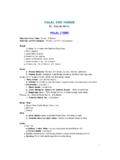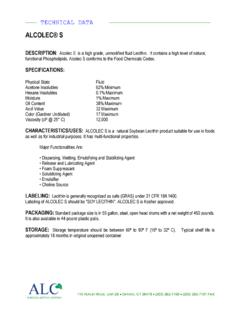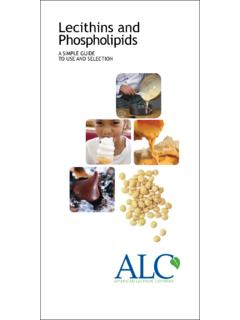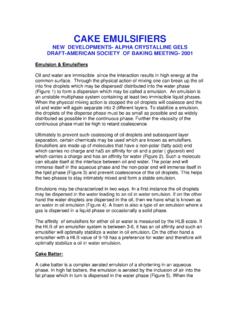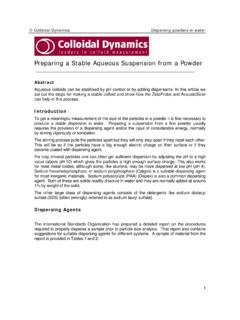Transcription of Innovations in Continuous Lecithin Drying - avta …
1 IntroductionSince the 1980 s, many changes in the industrialapplication of Drying Lecithin have occurred. This paperoutlines the changes in terms of capacity, moisture andcolor requirements, and GMO concerns. Also discussedare methods to deal with these changes as well as dealingwith issues such as acid number, AI adjustments andenvironmental 1980, most evaporators sold for Continuous dryingwere for Soy Lecithin plants processing 500-1200 shorttons/day of beans. This equates for 225-500 kg/hr ofdry Gums. A Continuous Drying plant of this size usingthin film Drying technology utilizes evaporators of 2 to6 M2 (of heat transfer area).Today, most applications in North America for SoyBased Lecithin require a nominal 10 M2 of heat transferarea. For Latin American applications, most applicationsnow require 25-40 M2 of heat transfer ContentThe wet gums from the centrifuge normally have amoisture content of 30-50%.
2 Prior to calendar year2000, most dry gum moisture specifications were <1%moisture. Today, the residual moisture specificationsare < and can be from Genetically Modified Soybeans wasnormal until 2000 and is still common in North American Soy Beans are often certified Non-GMO and are processed in the same manner as theSoy Bean applications in North America. However,Non-GMO plants using non-Soy Oil Seeds such asSunflower have smaller capacities and the gums can bemore viscous than the traditional Soy Bean is a Thin Film Evaporator?A Thin Film Evaporator allows for the Continuous ,reliable processing of viscous materials and heat sensitiveproducts without degradation. Thin-Film Evaporationseparates water from Dry Gums/Oil using: Indirect heat transfer Mechanical agitation of a thin product film Vacuum Short residence time Open low pressure-drop configurationTraditional Operating Conditions Heating Temperature - 162 C Product Temperature 110 C Steam Pressure bar Vacuum - 50 mmHg absolute Rotor Speed 12 m/secThere are many variations of the agitated film evaporatorincluding evaporator orientation (vertical or horizontal),cylinder bore (tapered or straight), and wiper type.
3 Thewiper type is critical and must be a rigid type rotor asopposed to a wiper type. This is due to a vacuum coolingeffect in the evaporator that causes a viscosity spikeduring the Drying particular orientation and type of cylinder bore areoften touted by manufacturers as having majoradvantages but experience shows that these are minorconcerns. The decision to use a vertical or horizontalevaporator will have little effect on the final either case, the residence time is very low. Often atapered bore is touted to achieve lower moisture contentInnovations in Continuous Lecithin DryingVTA GmbH 112 Hitching Post Lane, Rock Hill, SC 29732 USAemail: 803-980-2882, fax 803-980-2881 to a longer residence time in the evaporator. Noevidence has been submitted to substantiate that residual moistures in the to 1% range, theagitation is sufficient such that the final moisture is afunction of equilibrium between the concentratetemperature and the vacuum applied.
4 In fact, theadditional residence time from the tapered body maycause unwanted color in the dry the Batch Process AlternativeFor years, the wet gums have been successfully driedin a batch process using a jacketed vessel with a specialagitator heated with hot water. A batch system operatesat low heating temperatures and increasing vacuumlevels to produce a dry Lecithin gum with good colorand low moisture content. Batch systems have theadvantage of not being sensitive to incoming moisturelevels. Very low moisture contents are achievable dueto long batch times and increasingly deep , the disadvantages include long batchprocessing times, limited capacities, high operatorsupervision and the danger of a process upset damagingan entire batch. Batch systems are well suited for new installations are for larger capacities, and forthis reason, are Continuous . A Continuous process canhandle large capacities with a single processing line,produces a dry gum with low moisture (< in asingle pass and much lower with two evaporators inseries) with good color, and requires minimal operatorsupervision.
5 As with any Continuous process, the heatingand condensing load are constant requiring smallervapor handling equipment and a lower peak utility Dry Gum Specifications Minimum Acetone Insoluble Content: 62% Maximum Moisture Content: 1% Maximum Hexane Insoluble Content: Acid Value (mg KOH/g): 32 Maximum Gardner Color (5% solution): 10 Today s Requirements Dry Gums Moisture-as low as Non-GMO Capable (High Torque Drives) On-line AI Adjustments Acid # Adjustments Environmentally Compliant High CapacitiesTo achieve dry gums moisture content of or lower,a 2 stage process is recommended with the first evap-orator operating at 50 torr and a second operating at5 torr. To demonstrate why, let us first consider thecase of using only one evaporator. For a single stageevaporator to produce a moisture content of < inthe dry gums, an operating pressure of 25 torr and aminimum dry gums temperature of 100 C are achieve moisture contents any lower than willrequire either an increase in dry gums temperaturewhich will cause increased color, or lowering theoperating pressure which will make the peak viscosityalmost we operate at 50 torr in the first evaporator, we cankeep the dry gums temperature close to 100 C, and inthe second stage evaporator (where there will be minimalflash cooling now due to lower moisture content), wecan operate at 5 torr and achieve moisture contents inthe range of and maintain a dry gums temperatureon 100 C.
6 Because the second stage is operating in amass transfer mode rather than a heat transfer mode,smaller evaporator sizes are required for this stage. Thesecond stage is typically only 20% of the first stage interms of surface GmbH 112 Hitching Post Lane, Rock Hill, SC 29732 USAemail: 803-980-2882, fax 803-980-2881 rigid rotorHorizontal evaporatorTo maintain good color, the dry gums must beimmediately cooled to 55 C. This is most commonlydone with a scraped surface heat exchanger, but canalso be done with a spiral heat exchanger if care is takennot to allow the gums to cool below the desired temp-erature and plug the heat exchanger. The scraped surfaceheat exchanger requires a greater capital cost, but ismore forgiving in areas to consider when designing a LecithinDrying system are the vacuum system and associatedwater treatment, Acetone Insoluble s adjustment, andAcid Number vacuum system is typically a steam jet ejector systemwith a direct contact condenser.
7 A direct contact (spray)condenser is normally recommended over a surfacecondenser to avoid fouling of the tubes by entrainedorganics. These organics can be removed by treatingthe overflow of the hot well. This oil water separationcan be as simple as a decanter to remove any rag layerprior to sending the oil-contaminated water to thewater treatment facility. If further oil separation isrequired, a coalescing filter can be used to reduce theoil to 50 ppm. If the water needs further purification(for instance, if the water were to be re-used as boilerfeed water), this can be accomplished with amicrofiltration thin-film evaporator can process gums with AIcontent up to 70%. However, most specifications areonly 63% and the lower AI product is much less viscousand easier to handle. For this reason, the AI contentis frequently adjusted by adding refined oil. This isfrequently done prior to the feed of the TFE, or evenin a second feed nozzle in the TFE since the rotormakes an excellent mixer.
8 Care must be taken not toadd too much oil considering that the Acid Numbermay need to be adjusted later on and this will also affectthe , the scope of supply for the vendor should beconsidered. A vendor able to supply skid mountedsystems will typically have a lower installed cost, shorterdelivery, faster ROI and lower risk compared to theclient supplying this part of the GmbH 112 Hitching Post Lane, Rock Hill, SC 29732 USAemail: 803-980-2882, fax 803-980-2881 here to view VTA s websiteClick here to email VTA
